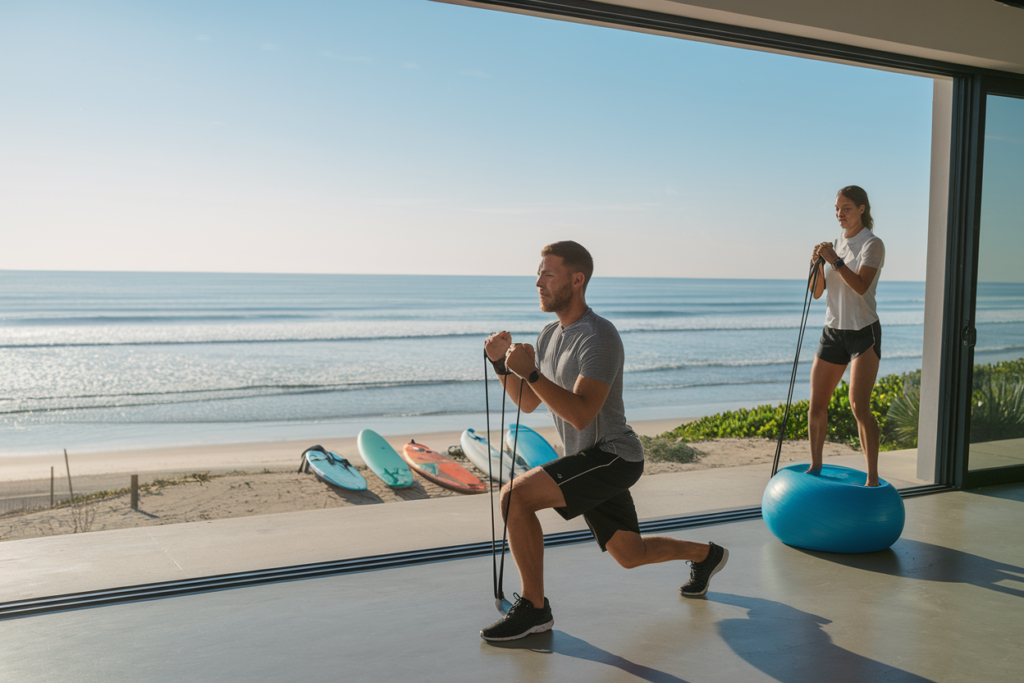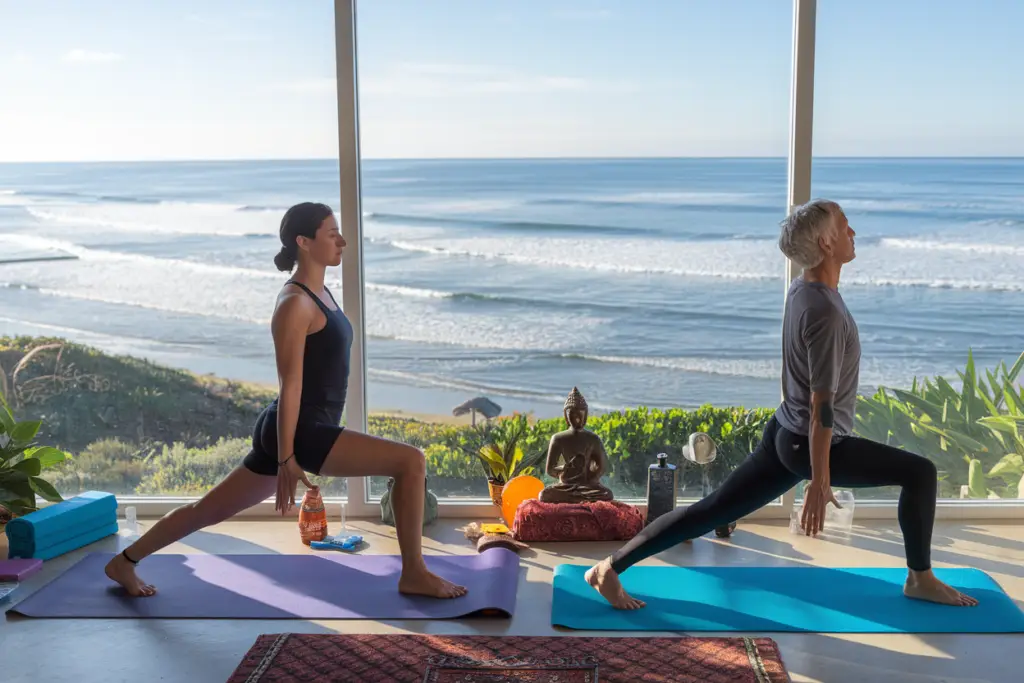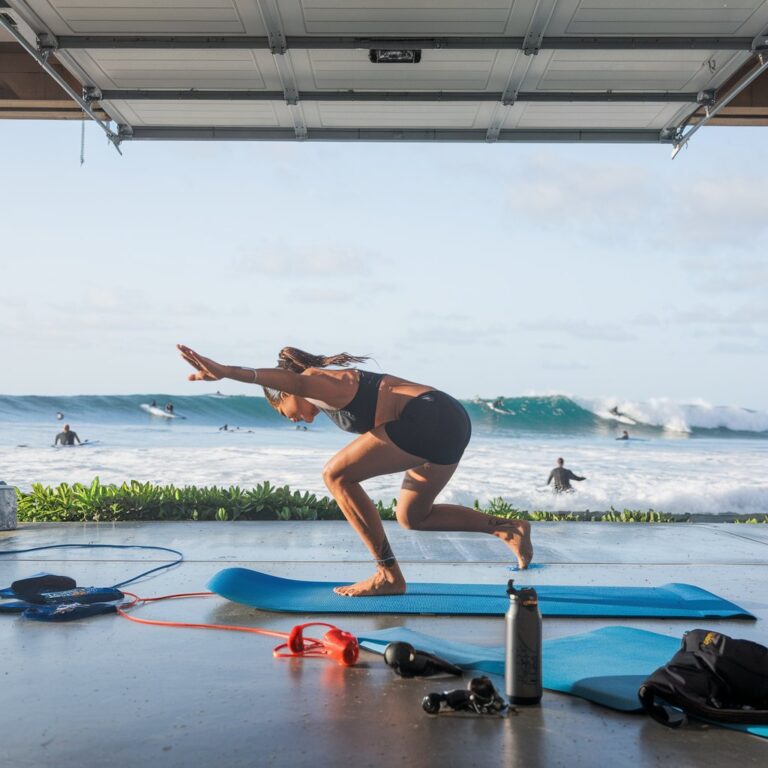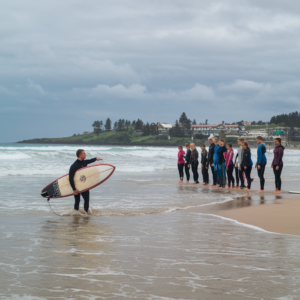Surfing is a great way to get outside and get some exercise. I am always tired after a long day at the beach and surfing is a great way to burn calories.
That being said, the marketing campaigns of the major surf companies use beautiful people and pro surfers with tanned, toned bodies to promote the “surfer’s physique”, which is an unrealistic and unattainable ideal for the majority of the surfing population.
Even though we may not look like pro surfers, we can learn from the habits of surfing’s elite athletes to help us train harder, get in shape and continue to improve our skills.
I often hear beginner surfers talk about how tired they feel after going surfing for the first time. I was talking to a young surfer at work and I was asked the question, “How many calories will I burn surfing and will it help me lose weight?”
So, I did some research to help provide some background information for this post.
Although surfing isn’t the most effective sport for weight loss, it is a fun activity that promotes healthy habits. Surfing is a lifestyle sport that helps individuals develop strength, flexibility and an appreciation for nature, all while burning 200-400 calories per hour.
Whatever your goals, the simplest way to achieve success is to start taking small steps in the direction that you want to go!
1. Surfing & Calorie Burn
As a starting point, it is useful to know how many calories we burn when we go surfing. That way we can compare surfing to other common sports and activities, which helps inform our fitness plan.
The number of calories burned when surfing is a very popular subject. I can’t count the number of times I have discussed, disagreed or debated the different estimates of the number of calories my friends and I have burned for a particular surf session.
You’ll often hear surfers say something like, “I am so tired, I must have burned 1000 calories during that session!”
I don’t want to get too technical but I wanted to define a couple of terms before we go any further.
Calorie (kcal):
- The amount of heat needed to raise the temperature of 1 kilogram of water by 1 degree Celsius.
- A unit of measurement used in nutrition.
Metabolic Equivalent Task (MET)
- A way to measure the effectiveness of exercise
- 1 MET is equal to the energy cost of sitting quietly
In order to help compare surfing to other sports and activities, I used the Compendium of Physical Activities, a resource maintained by the Arizona State University – Healthy Lifestyles Research Center.
The information, which lists the MET’s for hundreds of different physical activities, is used to calculate energy cost. It is used by researchers around the world
Put simply, if you know the MET for a particular physical activity and the weight in kilograms (kg) of an individual, you can calculate the calories (kcal) burned per hour using the formula below.
Calculating Energy Expenditure
| Calories (kcal) burned per hour = MET x weight in kilograms (kg) |
I hope I haven’t confused you so far! I used the calculation above to create a helpful reference table below comparing the hourly calorie burn of surfing to other common sports and activities.
Hourly Calorie Burn Rate For Surfing and other Sports & Activities
| MET | 70 kg Person(154 lbs) | 95 kg Person(209 lbs) | 120 kg Person(264 lbs) | |
| Lying quietly and watching television | 1 | 70 kcal/hr | 95 kcal/hr | 120 kcal/hr |
| Surfing, general | 3 | 210 kcal/hr | 285 kcal/hr | 360 kcal/hr |
| Surfing, pro | 5 | 350 kcal/hr | 475 kcal/hr | 600 kcal/hr |
| Walking, strolling slow | 2 | 140 kcal/hr | 190 kcal/hr | 190 kcal/hr |
| Walking, 3.5 mph, brisk pace | 4.3 | 301 kcal/hr | 409 kcal/hr | 516 kcal/hr |
| Running, 5 mph (12 min/mile) | 8.3 | 581 kcal/hr | 789 kcal/hr | 996 kcal/hr |
| Biking, leisure, 9.4 mph | 5.8 | 406 kcal/hr | 551 kcal/hr | 696 kcal/hr |
| Swimming (front crawl light-moderate effort) | 5.8 | 406 kcal/hr | 551 kcal/hr | 696 kcal/hr |
| Yoga, power | 4.0 | 280 kcal/hr | 380 kcal/hr | 480 kcal/hr |
| Circuit Training, moderate effort | 4.3 | 301 kcal/hr | 409 kcal/hr | 516 kcal/hr |
| Resistance (Weight) Training | 3.5 | 245 kcal/hr | 332 kcal/hr | 420 kcal/hr |
I was surprised by the results. Surfing is a sport that shows up low on the MET scale relative to other sports.
I didn’t realize that the estimated calories burned per hour for surfing was lower than other common activities like running, biking, swimming and even brisk walking.
I think Surfing ranks lower than other sports because the effort isn’t always constant and there may be a fair amount of time spent sitting on your surfboard waiting for waves.
In my experience, there are a number of factors that contribute to improved fitness and knowing the calorie burn is only the first piece of the puzzle.
For a more in depth analysis, read this article: Does Surfing Burn Calories? 10 Fitness Tips to Help Surfers Get in Shape
2. Cross Training

The more you surf, the more you will improve and the stronger you will become. But surfing everyday and “surfing yourself into shape” isn’t practical for the average person. I live more than an hour drive from the beach, so I am unable to surf everyday while managing a job and family time.
If you want to improve your surfing and you aren’t able to surf multiple times per week, cross training is a great to get fit and strong.
Cross training is just the act of doing other activities, like running, swimming or biking, that help you gain fitness for your main activity, which is surfing.
Any type activity or sport that gets you moving and your heart pumping, will help provide crossover benefits for your surfing.
I have found that walking, hiking, jogging, biking, swimming and Yoga, are some of the most effective activities to improve fitness and they don’t require a lot of equipment or an expensive health club membership.
Sometimes it’s hard to get organized and motivated but we all feel better once we are being active. Getting out the door is always the hardest part. We have started hiking on the weekends with our daughter and it is a great way to get some exercise as a family.
3. Strength/Resistance Training
Strength and or resistance training is an effective way to burn fat and increase your calorie-burning ability even after your workout.
Many people may think that cardio exercises, like running or biking, are the best exercises for weight loss, but strength/resistance training will help you realize long term results as well.
Strength and resistance training makes your body stronger by challenging your muscles to work against other forces. You can do it home, join a health club or participate in fitness classes. Strength training includes any exercises that use free weights, resistance machines, bands or body weight.
If you aren’t following a regular strength training routine, it can be difficult to get started. I found some great tips online from John Hopkins Medicine that highlights some important precautions to consider and healthy ways to start your practice.
You will see the best results if you follow a regular workout plan that combines strength/resistance training and cardio exercises together.
Don’t be discouraged if you feel like you are a long way from being in top form; making the decision to change your habits and do some regular strength training will pay off the next time you go surfing.
4. Up Your Outdoor Beach Time
Surfing is an outdoor activity. Pursuing a sport that occurs in the ocean is a great way to interact with the natural world and spend more time outside.
The surfing lifestyle revolves around the beach. Surfing stokes an enthusiasm for riding waves, an appreciation for nature and an interest in connecting with other surfers.
Just by the nature of the sport, surfers spend more time outside. When I go surfing, it usually takes most of the day. Although catching waves is a priority, most of the day looks more like the photo below of my daughter digging in the sand.
My wife, daughter and I dig holes together, make sand castles, run on the beach and search for sea creatures. We get to be near the ocean, breathing the sea air and focusing on meaningful activities that promote a healthy life.
The beach is a big, beautiful playground to enjoy and explore. It is also a great distraction from the busyness of everyday life. Go to the beach, pack healthy snacks and stay outside all day!
5. Eat Healthy
Eating healthy means different things to different people. We are all unique and our food choices differ based on our preferences.
I have found that eating non-processed, real food is the best way to fuel myself for Surfing and other physical activities. When I eat too much sugar or processed food, I end up feeling tired and unmotivated.
There are thousands of different articles about nutrition and diet and it is important that you find a plan that is right for you. I often eat too many calories throughout the day and snack too much at night when I am relaxing and watching TV.
According to WebMD, drinking plenty of water and avoiding extra night time snacks are the top tips for staying on track with your nutrition plan. But it is important to eat the foods you like, but only in moderation. You can read the full article on WebMD.
My wife and I are trying to teach our daughter about healthy eating. It’s amazing how quickly kids learn and even at four years old she knows which foods are healthy.
That doesn’t stop her from lying on the floor, crying hysterically and demanding a sugary treat…..but it’s hard to fault her because I sometimes feel the same way!
6. Make Activity Social
People are social creatures. We get energy from being around others.
Surfing, or any sport for that matter, is more fun when you share it with other people.
One of the best feelings in surfing is when you are paddling for a wave and another surfer gives you a hoot of encouragement for your effort. It’s how surfers support and cheer for each other.
There are many different ways to make Surfing, or any activity, more social. You can invite friends, carpool with others or chat with other surfers in the water.
If you don’t know a lot of surfers, consider the following options to make friends and meet like minded people.
- Join a Surfing Club. Check out the global Coalition of Surfing Clubs by clicking here.
- Join a Surfing focused non-profit like the Surfrider Foundation. More information can be found by clicking here.
- Ask about events at your local surf shop. Beach clean ups, kids events and demo days are great ways to meet other.
- Check out Online forums to meet other surfers in your area.
You don’t have to be active by yourself. Put yourself out there, you will be surprised how quickly you see familiar faces and they start hooting for you!
7. Set Goals
Surfing is often called a lifestyle sport, which refers to the fact that most surfers participate in an informal way rather than through competition. The feeling of catching a wave is what keeps surfers coming back time and time again.
With organized activities, like participating in a 5 km running race, motivation comes from a desire to achieve a clearly defined goal.
In surfing, it can be challenging to create goals because waves are unique and unpredictable. Surfing is a pursuit that requires you to define your own version of success.
I enjoy working towards an end goal and surfing challenges me to shift my thinking. I am motivated to improve and recreate the amazing feeling of catching waves. I am training for a healthy life.
Here are some common surfing goals for you to consider:
Surfing Goals
- Sign up for a surfing lesson
- Go surfing for the first time
- Stand up on a Wave
- Improve fitness and flexibility
- Try a new trick
- Catch the Best Wave of Your Life
- Surf Everyday for a Week
Check out the video below of a surfer that has surfed everyday for six years!
It is important to stay focused on the goals that you want to achieve. If you aren’t too sure how to set goals for yourself, consider setting SMART goals, which is an acronym that breaks goals setting down into five different categories, Specific, Measurable, Achievable, Realistic and Timely.
Check out the video below, which explains how to set SMART goals.
8. Get More Sleep
Several years ago, I attended a conference where I remember listening to a speaker that was talking about the importance of sleep.
I don’t remember the name of the speaker but there were two pieces of advice I remember from the talk.
- “Nothing good happens after 9:30 pm”
- “Make appointments with yourself in the morning”
Those statements might not resonate with you, but let me explain why I found them to be applicable in everyday life. For me, if I go to bed at a reasonable time I will get more sleep. It’s pretty simple, if I watch TV, surf the Internet or watch YouTube late into the evening, I feel tired the next day.
The talk was focused on how better sleep allows us to plan our day and focus on the goals that are most the important.
“Making appointments with yourself in the morning” is a reminder to schedule the activities that support your goals, like meditation or exercise first thing in the morning before life gets chaotic.
If you leave things until later in the day, there is a greater chance that you won’t have time or you will become distracted with other obligations.
If I go to bed at a reasonable time, wake up early and make appointments with myself first thing in the morning, I find that it is easier to work towards the goals that are important to me.
9. Less Stress
According to the American Brain Society, stress can negatively impact your physical condition and emotional well being.

Stress is a killer and it is something that impacts everyone. Some people are better at managing stress than others. It is common knowledge that regular physical activity and exercise will help reduce stress and improve your overall well being.
Surfing has been proven to reduce stress and anxiety and improve overall mood. Researchers at the University of Hawaii studied a large group of surfers and found that they reported fewer symptoms of stress and anxiety compared to the normal population.
The article was published in the Journal of Clinical Sports Psychology states that although research on the psychological effects of ocean surfing is limited, substantial anecdotal evidence suggests that the sport provides a uniquely positive experience.
Previous studies have shown that surfers tend to report fewer symptoms of depression and anxiety compared to the general population, but the reasons for this remain unclear. Given that higher levels of spirituality are associated with lower levels of depression and anxiety, and many surfers describe their experiences as spiritual, a connection might exist.
To explore this, a study was conducted with 100 surfers from the Hawaiian Islands and the mid-Atlantic region of the United States. Participants detailed their surfing habits and the spiritual aspects of their surfing experiences. Standardized tests were employed to assess spirituality, depression, and anxiety levels.
The results revealed that surfers reported fewer symptoms of depression and anxiety compared to most normative groups. Additionally, higher spirituality was linked to reduced depression and more profound spiritual experiences while surfing.
10. Be Mindful
The definition of the word mindful, according to the Cambridge Dictionary, is being aware of your mind, body and feelings in order to create a feeling of calm.
The ocean environment is naturally calming and Surfing is often described as a meditative experience. The power of the ocean is unparalleled and the sound of crashing waves is very relaxing.
When I am at the beach, everyday sounds like revving car engines and honking horns are drowned out by the sounds of seagulls cawing and waves breaking. The singular focus of catching waves helps focus my attention on the present rather than the future.
When I am surfing in the ocean, there are no distractions like phones, tv’s or outside chatter. My entire focus is directed towards paddling, getting in position and caching waves.
Surfing is a constant reminder that there are things that are bigger than me. Being mindful is a great way to reset, own your own thoughts and be kind to yourself.
I am not very good at it but I try and be mindful in everyday life when I am not surfing. Yoga, meditation or just sitting quietly are all great ways to follow a regular mindfulness practice. I think of it as a way to practice being positive everyday.
Conclusion
Being in the right place at the right time to catch waves is one of the greatest challenges in surfing.
Surfers require superior fitness to paddle, position and catch waves. In reality, surfers don’t get very many chances to ride waves because the ocean is unpredictable. So it’s important to develop the strength and endurance in advance so you are ready when a waves comes your way.
It’s a great metaphor for life: Train to be ready for whatever comes your way.
Persistence, determination and a positive attitude will help propel you to a fitter and happier you. Best of luck, you can do it.
You may also be interested in the following articles:
Is Surfing Exhausting? 10 Reasons Surfers Get Tired



